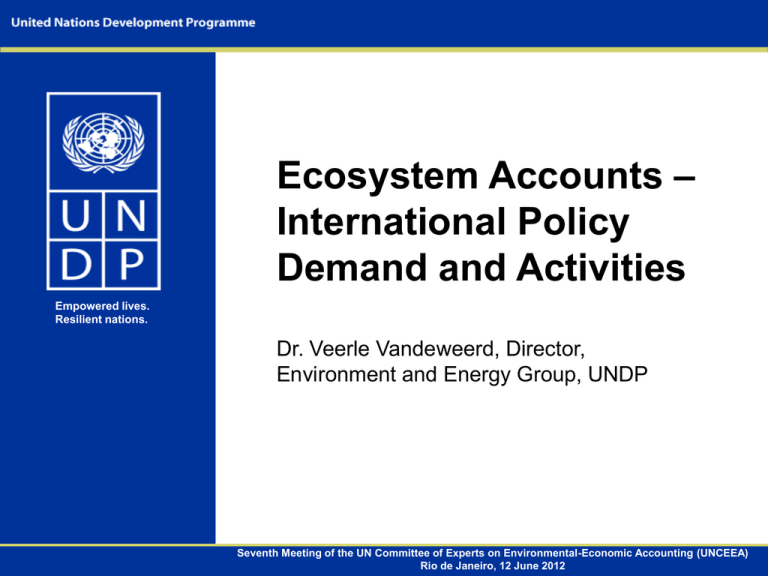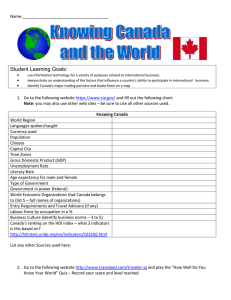– Ecosystem Accounts International Policy Demand and Activities
advertisement

Ecosystem Accounts – International Policy Demand and Activities Empowered lives. Resilient nations. Dr. Veerle Vandeweerd, Director, Environment and Energy Group, UNDP Seventh Meeting of the UN Committee of Experts on Environmental-Economic Accounting (UNCEEA) Rio de Janeiro, 12 June 2012 • What questions can we answer with ecosystem accounts? • Why do we need an accounting approach? • How to start implementing ecosystem accounts? Integrated systems of comparable national data, including economic and environmental accounts, are key to helping countries design inclusive, equitable, low-emission, climate resilient development strategies. 2 Key Initiatives • • • • • Human Development Indices UNEP GEO Report Poverty Environment Initiative IPBES Low-Emission Climate Resilient Development Strategies • Post-2015 MDG Data Needs 3 Family of HD Indices • Human Development Index • Gender-Inequality Index • Multi-dimensional Poverty Index 4 Equity and Sustainability Key messages from Human Development Report 2011 Equity and sustainability are inextricably linked one will not be achieved without the other Positive synergies exist between equity and sustainability that can offer win-win-win solutions for development. These positive synergies do not happen by themselves – they require deliberate policy choices and investment decisions And policies need to be informed by better data. 5 Equity and Sustainability Key messages from the Human Development Report 2011 • Can we expect the positive HDI trends of the last forty years to continue in the future? • Based on environmental degradation trends, a range of projections made on our world in 2050. • HDR 2011 warning: escalating environmental hazards threaten to slow or reverse HDI progress. • Impact is projected to be worse for countries of low HDI, leading to widening inequalities between high HDI and low HDI countries. 6 Environment and inequality threats to human development 7 Greening HDI • how to link present choices with future choices - do they have same weight? • how to reflect ‘planetary boundaries’, ‘tipping points’ given that climate change in particular is imposing significant costs on poor nations and communities? • how to capture issues of global responsibility while ensuring equal rights of all citizens? Comparable sets of national ecosystem accounts data from as many countries as possible is key. 8 UNEP GEO Report 2012 - Measures progress towards and gaps in achieving 90 global environmental goals - Also identifies , using key indicators and time-series datasets, - In many cases, specific, measurable targets and/or sufficient data were lacking. Illustrates both use and demand for better national environmental datasets. 9 UNDP-UNEP Poverty-Environment Initiative Launched in 2005 to support integrated planning for poverty reduction and inclusive green growth. Identifies evidence on economic and social benefits. Mali: - data management system and poverty-environment indicators developed - sectoral environmental assessments conducted - green accounting promoted. Bhutan: - vulnerable groups identified, 50 villages supported - indicators for Gross National Happiness Survey - poverty‐environment issues in Local Planning 10 IPBES Intergovernmental Platform on Biodiversity and Ecosystem Services A new and evolving body designed to enhance the quality and timeliness of work between scientists and policymakers at the national, regional, and global level. Recognizes need for more informed policies by jointly presenting poverty alleviation and biodiversity agendas to policymakers. UNDP, sister agencies, and partners working to develop IPBES capacities including by drawing on national ecosystems accounts data where available. 11 Green Low Emission Climate-Resilient Development Strategies • As largest source of technical assistance on environment and energy in UN system, UNDP supports developing countries in the transformational economic shift to green, lowemission, climate-resilient development that supports the MDGs and poverty reduction. • Vulnerable groups and groups with low adaptive capacities are priority for UNDP support. LDCs and SIDSs are part of these priority groups. 12 4-step process for selecting the appropriate combination of policy, technology and financial instruments II. DEFINE BARRIERS I. IDENTIFY PRIORITY OPTIONS Behavioral barriers Institutional barriers Regulatory barriers Technical barriers Financial barriers III. SELECT APPROPRIATE MIX AND SEQUENCE OF SUPPORT POLICIES IV. SELECT FUNDING OPTIONS INTERNATIONAL Public Funds Innovative finance Private Funds NATIONAL & SUB-NATIONAL information based instruments Regulations Market-Based Instruments Tax-based mechanisms Early market-based development mechanisms Debt and equity –based mechanisms Trading mechanisms 13 post-2015 Development Goals and Data Needs • MDG progress needed through 2015 • Discussions have begun on goals and targets that could build on and succeed the MDGs, including environment goals and ongoing debates on Sustainable Development Goals. • Goals, targets, and indicators still be decided through stakeholder consultations • The demand for comparable national sustainable development data sets, including ecosystem accounts, will continue to grow. 14 Thank You

